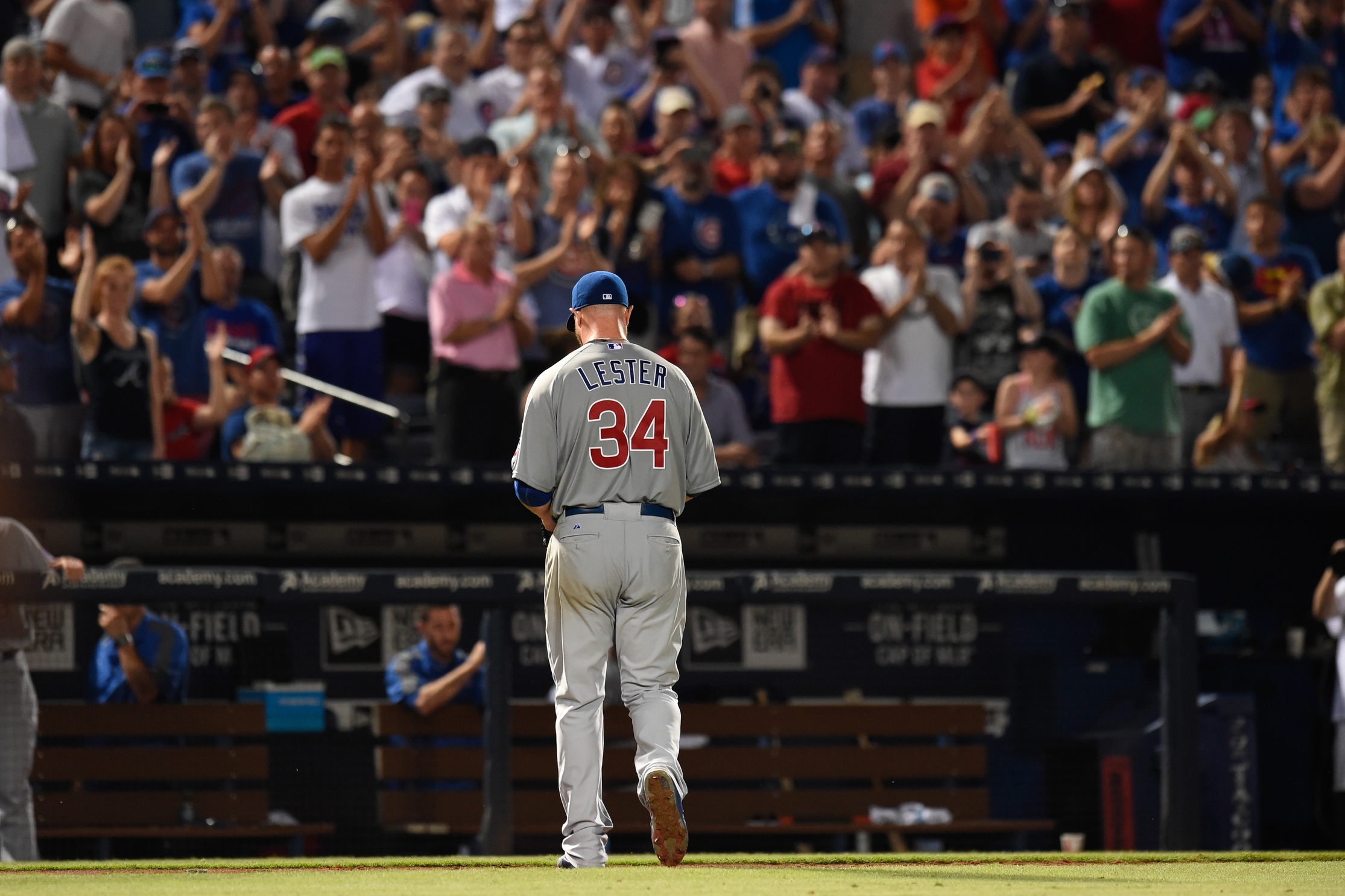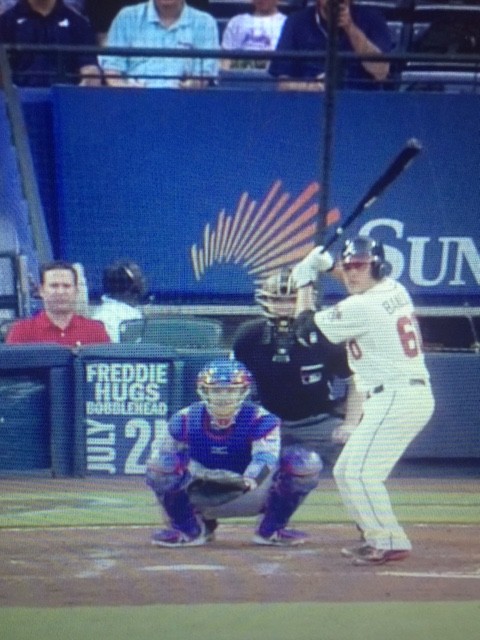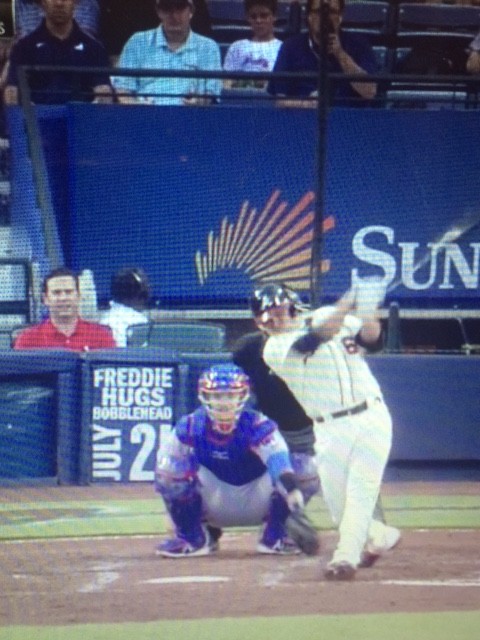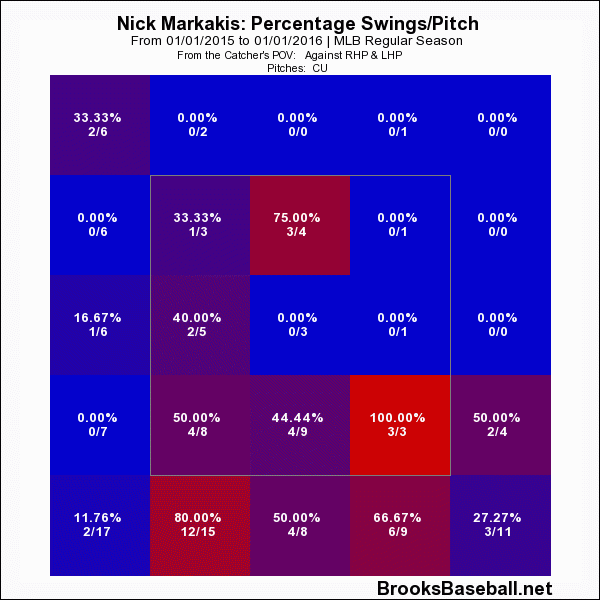Date: July 18, 2015
Opponent: Atlanta Braves
Location: Turner Field
Introduction
When Jon Lester recorded his fourth victory of the season, Mad Men was still on the air, the Chicago Blackhawks had yet to begin the Western Conference Finals, and the Women’s World Cup was three weeks from opening in Canada.
It’s been awhile since Lester picked up a win, is what I’m trying to get across.
Saturday night in Atlanta was unquestionably Lester’s best start as a Cub. He pitched into the eighth inning for the first time since September 9, 2014, a stretch of 21 starts. Lester’s Game Score (80) was his best of the season, and highest since August 7th of last season, his second start with Oakland.
Lester was at his most efficient, needing more than 14 pitches to get through an inning just once. The Braves were passive, swinging at just 42 of 110 pitches (38.8 percent). Lester used this to his advantage, picking up a season high 14 called strikes on pitches in the strike zone. Overall, Lester picked up 21 called strikes, his third highest total of the season, and his best mark since mid-May. Lester entered the eighth inning having retired 16 of 17 batters.
Lester had all of his pitches working, and the Braves did not reach base against his four-seamer or curve (see Pitch Breakdown section). He threw first-pitch strikes to 16 of 26 batters (61.5 percent, slightly above his season average). Of the 16 first-pitch strikes, 11 were called strikes, meaning the Braves were letting Lester get ahead early in the count.
Of course, in 2015, the Atlanta Braves offense is the epitome of mediocre, entering the game in the middle of the pack in runs scored, doubles, batting average, and on-base percentage. The team hits for decidedly little power, ranking last in the NL in home runs and ISO, and third worst in slugging percentage. Of the six players with at least 240 plate appearances, only the currently DLed Freddie Freeman has an OPS above .775. The Braves offense has been especially poor against left-handed pitchers, posting a line of just .236/.307/.333 when facing southpaws.
Like Sherman before him, Lester stormed through Atlanta. Mediocre offense notwithstanding, Lester was very good on Saturday. He worked quickly and efficiently, and even hit former Red Sox teammate A.J. Pierzynski, earning him the plaudits of 29 MLB teams. Scroll down a few inches to learn more about Lester’s best start of 2015.
Traditional Line
7.1 IP, 2 H, 7 K, 1 BB, 0 ER
Pitch Breakdown
110 pitches (63 strikes)
| Total | Velocity (Max) | AVG | SLG | BABIP | |
| Four-Seam | 49 | 92.5 (94.4) | .000 | .000 | .000 |
| Cutter | 26 | 88.4 (90.4) | .143 | .143 | .200 |
| Sinker | 16 | 91.7 (93.2) | .250 | .250 | .250 |
| Change-Up | 3 | 83.5 (84.1) | .000 | .000 | .000 |
| Curveball | 16 | 73.8 (78.3) | .000 | .000 | .000 |
Lester’s 49 four-seam fastballs were his highest total since early May. And for the first time this season, he did not surrender a single hit or walk off the four-seamer. Lester produced just three whiffs with the pitch, but Braves hitters took 13 four-seamers for called strikes. Like we discussed in the Introduction section, Lester used the Braves passivity to his advantage.
Featuring the four-seamer heavily was likely part of Lester and David Ross’ game plan, as aside from Jonny Gomes and Chris Johnson, the Braves starting lineup has struggled against four-seamers from left-handed pitchers in 2015:
| Player | K% | AVG | SLP |
| Peterson | 13.7% | .211 | .263 |
| Maybin | 16.0% | .217 | .435 |
| Markakis | 29.0% | .263 | .316 |
| Gomes | 15.0% | .267 | .533 |
| Johnson | 18.2% | .455 | .546 |
| Pierzynski | 8.3% | .091 | .182 |
| Uribe | 14.3% | .167 | .167 |
| Simmons | 17.7% | .143 | .143 |
Lester’s cutter looked sharp against the Braves. He generated strikes on 17 of 26 cutters (65.4 percent), and he hit his spots with the greatest consistency of the season. In four July starts, Lester has gone to his cutter 32 percent of all pitches, a better than five point increase in usage from the season’s first three months. During July, opposing batters are hitting just .189/.250/.243 against the pitch, after hitting .313/.371/.500 through the end of June. On Saturday, Lester used the cutter to both put away batters and set-up his other pitches. In the third inning, with the count 2-and-2 on pitcher Manny Banuelos, Ross called for the cutter:
Lester’s 87.4 mph cutter cut sharply:
Banuelos was able to just get a piece of the pitch that cut sharply. On the next pitch, Lester got Banuelos to whiff on a curve on the inside corner for strike three.
After throwing a season-high 11 changeups against the White Sox, Lester threw just three on Saturday night. As we detailed above, it is likely due to the Braves struggles against four-seamers.
Lester’s curveball usage dropped below 15 percent for the first time since June 9th at Detroit. However, he still picked up two strikeouts, including a seventh-inning whiff of Nick Markakis (see Key At-Bat/Sequence section) after jumping ahead of him with fastballs. As we have discussed in the Ballad a few dozen times, Lester is at his best when he is getting ahead with his fastball to set-up the curve (as we detailed in this section and in the Key At-Bat/Sequence section).
Trends
As we will discuss in the KIM © section, Lester has put together an excellent seven start stretch since his abysmal outings in Miami and Detroit to open June.
During that time, Lester has seen across the board improvement with the three pitches he throws with the most frequency. In the 12 starts through June 9th, Lester had experienced mostly disappointing result with his fastballs:
| Frequency | K% | BB% | HR | AVG | SLP | BABIP | |
| Four-Seam | 41.61% | 33.1% | 7.4% | 5 | .277 | .482 | .347 |
| Cutter | 27.01% | 20.8% | 9.4% | 3 | .333 | .540 | .406 |
| Curve | 15.35% | 37.2% | 2.3% | 1 | .214 | .357 | .320 |
Since then, Lester has reduced his four-seam usage, while increasing his cutter and curve frequency. The results have been excellent:
| Frequency | K% | BB% | HR | AVG | SLP | BABIP | |
| Four-Seam | 37.85% | 20.0% | 10.0% | 1 | .222 | .400 | .265 |
| Cutter | 29.92% | 28.6% | 6.1% | 0 | .174 | .217 | .250 |
| Curve | 16.03% | 75.0% | 0.0% | 0 | .000 | .000 | .000 |
Lester’s three starts before the All-Star break were all cutter heavy (combined 34.9 percent usage rate). Against the Braves, he went to the cutter with less frequency, but he was still effective.
Lester has actually experienced a decrease in average velocity with both his four-seamer (92.86 to 92.47) and cutter (89.05 to 88.95). Additionally, since June 9th, there has not been a significant decrease in balls in play, line drive, or fly balls, or increase in whiffs.
What has changed is the average exit velocity for balls in play against both the four-seamer (91.16 to 87.11) and cutter (82.81 to 82.73). Along with a decrease in exit velocity has come a considerable, but expected stabilization of the BABIP against both the four-seamer and cutter (see charts above).
For six weeks now, Lester has found considerable success with all three of his most frequently thrown pitches. The curveball, of course, has been tremendous all season, and merits its own Trends section breakdown in the immediate future.
Key At-Bat/Sequence
Inning: Seventh Inning
Score: 0-0
Situation: Nick Markakis leading off the inning
Batter(s): Nick Markakis
This was, unquestionably, 2015’s most difficult Key At-Bat/Sequence section to complete. In pitching his best game of the season, Lester did not surrender a home run, give up a big inning, or pitch out of trouble—all hallmarks of the Key At-Bat/Sequence section. That’s right, there were no home runs surrendered on fastballs left over the plate to the likes of Nick Ahmed or Sean Rodriguez. There were no sinkers left over the plate to Howie Kendrick. For the most part, it was an efficient, continuous stretch of execution by Lester.
Entering the game, Markakis has struggled against both cutters (.263 AVG and .368 SLP) and curves (.233 AVG and .300 SLP). Lester and Ross attacked Markakis with both, demonstrating both an excellent game plan and execution.
On the the first pitch, Markakis took an 88.3 mph cutter over the plate for strike one. Ahead 0-and-1, Lester came back with an 86.3 mph cutter that missed its spot, but Markakis was able only to foul it off. On 0-and-2, Lester could not get Markakis to chase a 92.7 mph four-seamer off the plate.
In 2015, when Markakis had two strikes on him, pitchers went to fastballs 53 percent of the time.
On another 0-and-2, however, Lester got Markakis to chase and whiff on a curve in the dirt:
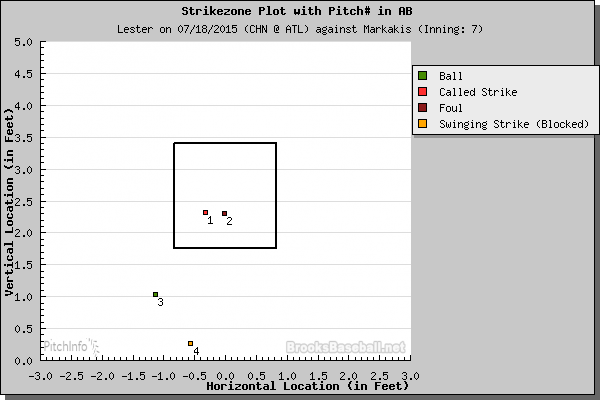
We detailed Markakis’s struggles against curves this season. As you can see below, he has struggled to hold up on curves out of the strike zone:
Lester and Ross set-up Markakis with three fastballs, and in a situation in which he has seen primarily fastballs in 2015, finished with a curve, a pitch he has been unable to lay off of this season. The at-bat encapsulated Lester’s night perfectly—getting ahead with fastballs early in the count, getting away with a mistake, and hitting his spots to put away Braves batters.
The at-bat also continued Lester’s career-long domination of Markakis. After Saturday night, Lester has faced him second most of any batter in his career. In 80 career plate appearances, Markakis has hit just .224/.263/.3012 with one home run.
Keep-In-Mind
After a few super-sized KIM © sections, we will keep it brief, but to the point: while this was Lester’s best start of 2015, he has quietly put together a solid 1.5 months since his disastrous outings in Miami and Detroit to open June (9.1 IP, 18 H, 3 BB, 2 HR, 11 ER). In seven starts, Lester has been allowing few baserunners and home runs:
| ERA | WHIP | K% | BB% | AVG | OBP | SLP | HR | |
| Since June 14 | 1.97 | 0.854 | 26.3% | 6.3% | .174 | .234 | .267 | 1 |
For all the panic and concern about Lester, he has seen both his ERA and DRA drop by nearly a full run since his awful start at Detroit.
Conclusion
Lester’s final start before the All-Star break was a poor capper to an inconsistent first half. As a result, a bad taste about his first season with the Cubs lingered throughout the break, and obscured the fact that he had looked great in May and very good since mid-June. On Saturday, his four-seam fastball was as effective as it has been all season, and his curve remained nearly unhittable. The Braves certainly helped Lester—taking strikes and failing to capitalize on handful of his missed locations. Lester’s first, second, and fourth best Game Scores of the season have come in his past four starts. It isn’t always pretty, but he is looking the part of an ace.
Season to Date
5-8, 3.37 ERA (4.72 DRA) , 1.207 WHIP, 23.7% K, 6.3% BB
Next Start
Friday, July 24th vs Philadelphia Phillies (Jerome Williams)
Lead photo courtesy of Dale Zanine-USA TODAY Sports
